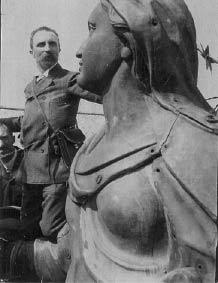The music of Giorgio Colombo Taccani has evolved, to date, along a considerable and uniform line. Unlike many young composers who often become involved in a complex quest for their own identity through the labyrinth of contemporary movements, Colombo Taccani appears to have found his own style early on, from his very first composition. The evolution of his language has always revolved around clear, well-defined technical and aesthetic categories: a search for refined harmonic and timbral beauty, attention to the technical and expressive qualities of the instruments – qualities which, starting from their natural state of simple ‘colours’, become supporting elements of musical structure – and a clear, deliberate formal clarity in all his works.
All this occurs without ever letting his listener forget the experience of the historical avant-garde, including its most innovative manifestations. Thus the quest for musical beauty, far from being nostalgic or backward-looking, arises from a study of the less traditional instrumental timbres, those very timbres that were considered as destabilising elements in the music of the twentieth century and that we encounter here, ‘re-functionalised’, as delicate sonorities worked into a rich but comprehensible form. We start with tones emptied by a puff of breath in the wind quartet
Di passaggio (1987), move on through the timbral effects of the string quartet
Al ritorno (1990), and arrive at
Chant d'hiver (1995) where the violin merges with electronic media to create a rare degree of musical and poetic homogeneity, or, more recently,
Vespri (2002) for ensemble, rich of bright and diverse colours, and, on a large scale,
Lied (1999/2003) for brass ensemble, percussions, mezzosoprano, mixed choir, strings and off stage wind instruments, on texts by Annette von Droste-Hülshoff, Friedrich Hölderlin and Rainer Maria Rilke. Colombo Taccani’s intensive work with electronic music, which has characterised some of his most recent works, encouraged him to work further in that genre: pieces like
Chant d'hiver mentioned above, or
Kyrie (1998) for trombone, tape and live electronics, combine the study of instrumental techniques with a clear and astute manipulation of the electronic material to create original soundscapes, sometimes evocative.
At the same time, over the last years Colombo Taccani has given a particular attention to those instruments that have been less explored by classical composers, as witnessed by his consistent output for the accordion, both as solo instrument (
Aria di sortita, 2001) or in diverse ensembles (for instance:
Diario di viaggio for accordion and violin, 1999). Moreover, we can encounter works for recorder (
Dichters Genesung, 2003) where it is combined with the harpsichord; for bass clarinet (
Golem, 2004); or for unusual ensembles, like
Il mare immobile (2001/05), version for two bass recorders, bass clarinet and marimba.
The nature of the works premiered to date would appear to confirm the evocative tension implied in Colombo Taccani’s poetics: his music, without being particularly programmatic, often does look outside itself, recalling extra-musical plots and relationships.
La notte viene col canto (1990) for piano or
Mit Äxten spielend (1999) for bass saxophone, with their references to Mario Luzi or Paul Celan, are not the only pieces to display this particular expressive need. The short fragments of poetry at the foot of some of the aforementioned works – “
Appostata ad una svolta dell’età finché fosse la tua ora” (
In waiting at a turning point of age, until your time had come) is a line from Luzi, used by the composer – clarify the desire to translate the impalpable essence of language, proposing a concept of poetic and musical imagery that escapes any descriptive confinement but brings with it a peculiar sensation of ‘elsewhere’; this would explain the affinities with a poet such as Paul Celan, whose poetries have been used in
Auge der Zeit (2001) for mezzosoprano and five instruments, and in
Abend der Worte (2003) for soprano and piano.
The composer’s exploration of acoustic and electronic sounds, timbres and verticalities, is the fertile soil in which this evocative spirit seems to flower, a spirit that cannot spring at random from words alone but requires the specific poetic leanings that the composer displays even in works lacking deliberate non-musical references. Generally speaking, an awareness of language and literary texts characterises Colombo Taccani’s entire output, being fully realised in his various vocal pieces: from the works for solo voice – like
Nox, Tellus (2004) on fragments from Ovid’s
Metamorphoses – to the works for choir – like
Oceano Deus (2004/05) for eight-part mixed choir on fragments from Luis Vas de Camões’s
Os Lusiadas – to works with narration, like
Ledi - per non dire il Macbeth (2000/01), based on the revised version of Verdi’s opera by Vittorio Sermonti.
But more important still, as we have said, is his clear desire to introduce his works into our contemporary aesthetic current, a stream that, far from rejecting the musical experiments of the twentieth century, views them with a positive but critical eye, reworking certain of their aspects into a more functional context. Clearly, Colombo Taccani is convinced that neither the art of music nor its experimentation have cast doubt on their reason for being but, rather, that they demand constant clarity and identification, which he considers to be vital factors in the attainment of an original and effective style.
(From Edizioni Suvini Zerboni brochure, 2006)